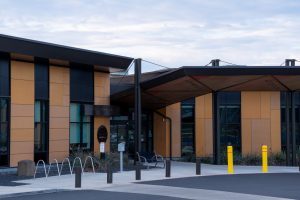By CHRIS AADLAND, The CUJ
MISSION – Standing on the edge of dry, brown fields near the Tamástslikt Cultural Institute (TCI) on Aug. 26, Confederated Tribes of the Umatilla Indian Reservation (CTUIR) Public Works director Justin Northern told about two dozen tribal leaders and federal officials gathered around him that much of area would likely soon be much wetter.
That’s because, Northern told those assembled on the edge of the fields and unused grassy areas, much of it was slated to be turned into a manmade wetlands area to protect “some our ancient groundwater that we’re currently pulling for irrigation” by doubling as retention ponds for millions of gallons of wastewater that had been recycled by a tribal sanitation infrastructure project that had taken a major step forward earlier that day when the federal government pledged to pay for much of the $44.5 million upgraded system.
Indian Health Service (IHS) officials had met with Board of Trustees members a couple hours earlier to sign a memorandum of agreement during a public ceremony that committed $38 million in federal funding to the project.
The new wastewater treatment system, according to the tribe, will meet the CTUIR’s sanitation system needs as it grows and pursues economic development initiatives while drastically reducing how much groundwater the tribe uses for irrigation purposes.
“This historical project is going to help our tribal membership and our enterprises, both of which are very important to us,” said CTUIR Chairman Gary I. Burke. “Water is very important to all of us. It sustains life. It is part of our religion and part of our first foods.”
The IHS’s financial commitment now allows the project – one of the Board of Trustee’s top priorities – to move forward. The project is the largest funding allocation in the IHS Portland Area Sanitation Facilities Construction Program’s 65-year history.
Oregon U.S. Sens. Jeff Merkley and Ron Wyden previously secured $3 million from the Environmental Protection Agency for project. The CTUIR will pay the remainder of the project’s costs.
According to the tribe, work is expected to begin in late 2025 and be completed about two years later. CTUIR’s Public Works department will manage the new system.
At capacity
The tribe’s sewer system dates to the 1970s and requires the tribe to pump some of its wastewater to Pendleton for treatment.
It also operates at capacity, and sometimes exceeds it, creating a potential for a sewage overflow only a couple hundred feet from the Umatilla River, said Lt. Michael Blasy, IHS’s Yakama Field Office senior environmental engineer.
IHS field visits to see the CTUIR’s sanitation system and witness how close it was to overflowing made it easy for him and others to convince high ranking decision makers that the CTUIR project should get federal funding, he said.
“Not only was this a public health issue, this is now an environmental issue,” Blasy said. “This is a problem.”
When completed, a wastewater recycling facility along Mission Road will treat up to 1.5 million gallons of water a day without chemicals by using a combination of ultraviolet light and a sludge of microorganisms that consume contaminants in polluted water. The system should be able to store about 92 million gallons of the reclaimed water.
The new system will quintuple how much tribal wastewater is recycled and available for reuse, Northern previously told the Confederated Umatilla Journal.
Once recycled, the water will be pumped to a 60-acre manmade wetlands area near TCI and Wildhorse Resort & Casino’s golf course.
The treated water won’t be safe for drinking but will be suitable for watering lawns and vegetable or fruit gardens. It will also be used to irrigate the golf course, which accounts for about a quarter of the CTUIR’s groundwater usage, Northern previously told the CUJ.
The area would also serve as habitat for birds, pollinators, waterfowl and native plants.
Walking trails and educational kiosks with information about the importance of First Foods and natural resources to the CTUIR would also potentially be added for community members and Wildhorse visitors.
By 2042, the tribe estimates that the new wastewater treatment system could prevent 444,000 gallons a day of the dwindling regional aquifer’s potable water from being used on crops or the golf course.
“That is equivalent to the annual permitted water production capacity of two to three additional community wells,” Northern said.
Tribal officials have said the new system would have the capacity to accommodate a growing tribal community and that preserving groundwater for other initiatives, like housing projects, would help spur tribal economic development.
According to a CTUIR press release, the IHS visit to the Umatilla India Reservation was the first event of many agency officials had planned for World Water Week to highlight tribal projects funded with help from the federal government and recognize the need for improved water and sanitation infrastructure in tribal communities. “I think what’s most important about this is that this really demonstrates to Indian Country how we’re being proactive in addressing the needs of over 41,000 American Indian [and] Alaska Natives that either need access to water or safe environmental situations at their homes or in their communities,” said IHS deputy director Benjamin Smith during the proposed wetlands site visit.




